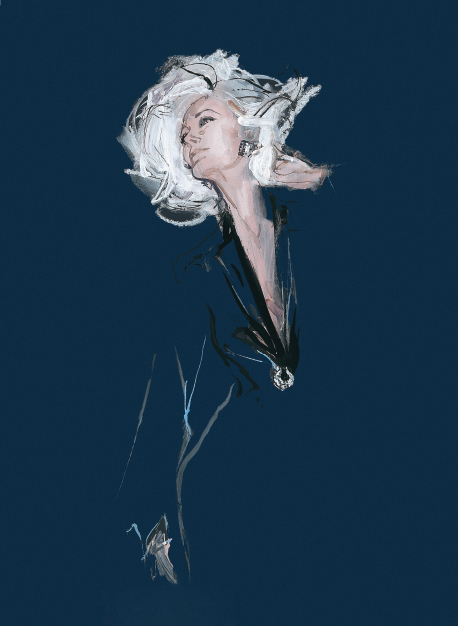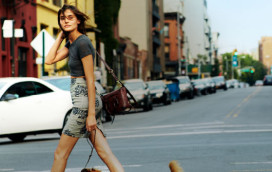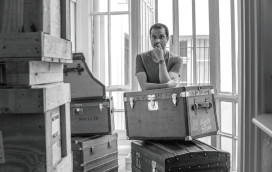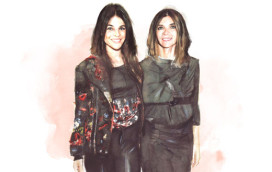During fashion’s flirtation with Surrealism in the late 1940s, Carmen Dell’Orefice, still in her teens, found herself at The St. Regis New York on a wildly extravagant set designed by the self-anointed high priest of the movement, Salvador Dalí. Cecil Beaton, a friend of Dalí’s, who was working at the Condé Nast studio on Lexington Avenue that day, dropped by to check on proceedings (the photographer was the matinee-idol-handsome Horst P. Horst).
Beaton had returned to New York after a tour of duty as a war photographer and was staying at The St. Regis New York, where his neighbors were Dalí, his wife Gala and their pet ocelot, Babou. Knowing that the artist was on the lookout for a model and that Carmen could use the extra money, Beaton had introduced the two over lunch at Le Pavillon – later La Côte Basque – and Carmen had agreed to pose. It’s the way things happened back then. “He was a showman,” says Carmen of Dalí. “It was all a performance, but one he very much enjoyed. He pretended he couldn’t speak English, but that was just part of the ruse.”
Carmen was supposed to represent La Primavera – a painting by Botticelli also known as The Allegory of Spring – and to be naked to the waist. “That didn’t bother me,” she says nonchalantly, “and it didn’t bother him.” Of much more interest were the charcoal drawings of horses that littered the floor of Dalí’s suite. One day he offered her one in lieu of payment. “I was getting my regular $12.50 an hour, so I said I’d have to go home and ask my mother about it. Now, my mother wasn’t stupid, but we needed the money so badly. She said no.”
Carmen Dell’Orefice has dozens of extraordinary tales to tell, and since she is celebrating 70 years working as a professional model, this would seem to be the perfect time to share them. Born in New York in 1931 to an Italian concert violinist and a Hungarian dancer, she began modeling at the age of 13 after a bout of rheumatic fever and a preternatural growth spurt left her too weak (and too tall) to pursue her early passion for ballet. Deemed to be “too mature-looking” for Seventeen and Junior Bazaar magazines, she began her career as a high-fashion model under exclusive contract to Vogue. Within weeks Carmen was working with the defining photographers of the era: Irving Penn, Erwin Blumenfeld, John Rawlings and Horst. “They were mentors who provided a gateway to the rest of my life and the world,” she says.
While Carmen spent her days modeling designs by Charles James and Mainbocher, life at home was somewhat different; with her father absent, she assumed the role of breadwinner and was soon paying the rent on the fourth-floor walk-up apartment she shared with her mother on Third Avenue. There was no telephone (until Horst eventually insisted she get one), so Vogue would dispatch a runner whenever her presence was required.
Photographs taken in the 1950s show Carmen variously as a blonde bombshell à la Monroe (with whom she modeled hats for society milliner Mr. John), a raven-haired society swan, and everything in between. “I was a chameleon, a silent actress. I was never an ‘It girl’,” she says. Her career reached a high-water mark in 1957 when she shot the Paris collections for Harper’s Bazaar with Richard Avedon, under the fashion direction of Diana Vreeland and the all-seeing eye of graphic genius Alexey Brodovitch.
Although Carmen never officially retired from modeling, in the mid-1960s she scaled back her work to concentrate on family life. She had married for a third time and had a daughter, Laura (today a psychotherapist), by her first husband. When that marriage ended in divorce a decade or so later she found herself in need of a job and made tentative steps back into the industry.
At a party she ran into her old friend Norman Parkinson, who declared that she “didn’t look bad for an old bag”, and flew her to Paris for French Vogue, relaunching her career. The resulting pictures were a sensation and revealed a new Carmen: sexy, silver-haired and on the brink of 50. Her old agency, Ford, opened a new division specifically to handle her, and once again she was working with the greatest photographers: Helmut Newton, Patrick Demarchelier, Arthur Elgort, Peter Lindbergh and Steven Meisel.
Things had changed radically since her heyday, with models now expected to be personalities as well as faces. Carmen quickly adapted. She wrote a beauty book, hit the chat-show circuit, took cameo roles in movies by Woody Allen and Michael Cimino, and appeared on the catwalk in earnest for the first time in her sixties. Along the way she made it into the Guinness Book of World Records (as the oldest professional model).
I first met Carmen in April 2000 after pestering her agents to see if she would consider sitting for me. She eventually agreed, and we arranged to meet at her apartment on the Upper East Side in Manhattan. When I arrived she was whipping her hair into its trademark white squall, “to give you something to draw”. She posed all afternoon with Sinatra and Ella Fitzgerald on the sound system, changing clothes, thinking things through, finding the line, and paying me the compliment of taking things seriously.
The drawings turned out well, and since then we have worked together whenever time and tide have permitted: in London, on the catwalk for Hardy Amies; in Paris, backstage at Dior; in Florence, in a deconsecrated church for Alberta Ferretti; and, coming full circle, last year at The St. Regis New York, almost 70 years after she posed for Dalí. For the occasion we hung one of Carmen’s own paintings by the artist on the wall, and felt the magic still.
What makes Carmen so inspiring to draw is that she has such an innate understanding of image-making. She has developed a sixth sense – or is it a third eye? – so that she sees what you see and “edits” herself accordingly for the page. There’s her beauty, of course, but that is just her opening play; she is also riotously funny, ribald when the mood takes her, and has the discipline instilled by decades on fashion’s front line.
Carmen has learned to be a gracious receiver of compliments, which is just as well, since they are the white noise of her life. “I know you hear this all the time,” gushed one lady of a certain age, when we were having dinner in New York recently. “I’ve never heard it from you,” was Carmen’s consummate reply.
And so she goes on. Standing sentinel at the age of 84 and staying true to her aim of representing her generation as positively as she is able. And although she is happy to talk about the past, she will not be pitching her tent there any time soon. There is a book to be getting on with, a documentary which is in the process of being edited, and the offers of work that keep on coming. “I am amazed by everything that is happening in my older old age,” she mused recently. “Perhaps today I am an It girl after all.”
David Downton: Portraits of the World’s Most Stylish Women is published in September by Laurence King
Your address: The St. Regis New York




